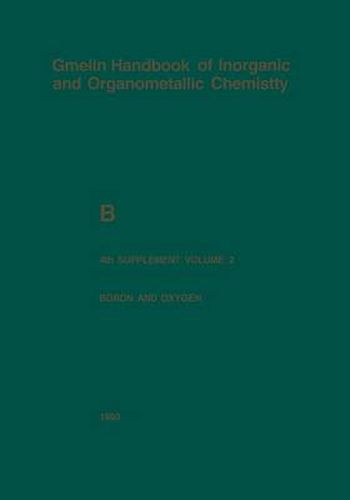Readings Newsletter
Become a Readings Member to make your shopping experience even easier.
Sign in or sign up for free!
You’re not far away from qualifying for FREE standard shipping within Australia
You’ve qualified for FREE standard shipping within Australia
The cart is loading…






This title is printed to order. This book may have been self-published. If so, we cannot guarantee the quality of the content. In the main most books will have gone through the editing process however some may not. We therefore suggest that you be aware of this before ordering this book. If in doubt check either the author or publisher’s details as we are unable to accept any returns unless they are faulty. Please contact us if you have any questions.
The present issue, Volume 2 of Boron Compounds 4th Supplement of the Gmelin Hand book, updates the previous issues by reporting the literature on boron-oxygen systems published up to 1988. For some important recent developments literature is covered through mid-1992; this concerns, for example, the compounds ~-Ba3[B306h and U[B305J which became of interest as materials with nonlinear optical properties. The volume directly com plements the earlier Boron Compounds 3rd Supplement Volume 2. In the original literature, alternative formulations are frequently used for the same com pound. This is especially true for many borates. Often, these species are neither completely heteropolar nor covalent, and an experimentally based decision has not been made. Hence, the use of brackets does not necessarily reflect a truly salt-like character. Volume 1 (systems with hydrogen and noble gases) of this particular supplement will be published subsequently, whereas Volume 3a (boron and nitrogen), Volume 3b (boron and nitrogen, boron and fluorine), and Volume 4 (boron compounds containing Cl, Br, I, S, Se, and Te, as well as a section containing carboranes) have already been published. All volumes of the 4th supplement will be augmented by a formula index. The IUPAC nomenclature is generally adhered to; thf means tetrahydrofuran; and occa sionally additional abbreviations for compounds are explained in the text. Positive signs for chemical shifts of the NMR signals indicates downfield shifts from the references, usually internal (CH3)4Si for olH and 013C with others being specified.
$9.00 standard shipping within Australia
FREE standard shipping within Australia for orders over $100.00
Express & International shipping calculated at checkout
This title is printed to order. This book may have been self-published. If so, we cannot guarantee the quality of the content. In the main most books will have gone through the editing process however some may not. We therefore suggest that you be aware of this before ordering this book. If in doubt check either the author or publisher’s details as we are unable to accept any returns unless they are faulty. Please contact us if you have any questions.
The present issue, Volume 2 of Boron Compounds 4th Supplement of the Gmelin Hand book, updates the previous issues by reporting the literature on boron-oxygen systems published up to 1988. For some important recent developments literature is covered through mid-1992; this concerns, for example, the compounds ~-Ba3[B306h and U[B305J which became of interest as materials with nonlinear optical properties. The volume directly com plements the earlier Boron Compounds 3rd Supplement Volume 2. In the original literature, alternative formulations are frequently used for the same com pound. This is especially true for many borates. Often, these species are neither completely heteropolar nor covalent, and an experimentally based decision has not been made. Hence, the use of brackets does not necessarily reflect a truly salt-like character. Volume 1 (systems with hydrogen and noble gases) of this particular supplement will be published subsequently, whereas Volume 3a (boron and nitrogen), Volume 3b (boron and nitrogen, boron and fluorine), and Volume 4 (boron compounds containing Cl, Br, I, S, Se, and Te, as well as a section containing carboranes) have already been published. All volumes of the 4th supplement will be augmented by a formula index. The IUPAC nomenclature is generally adhered to; thf means tetrahydrofuran; and occa sionally additional abbreviations for compounds are explained in the text. Positive signs for chemical shifts of the NMR signals indicates downfield shifts from the references, usually internal (CH3)4Si for olH and 013C with others being specified.